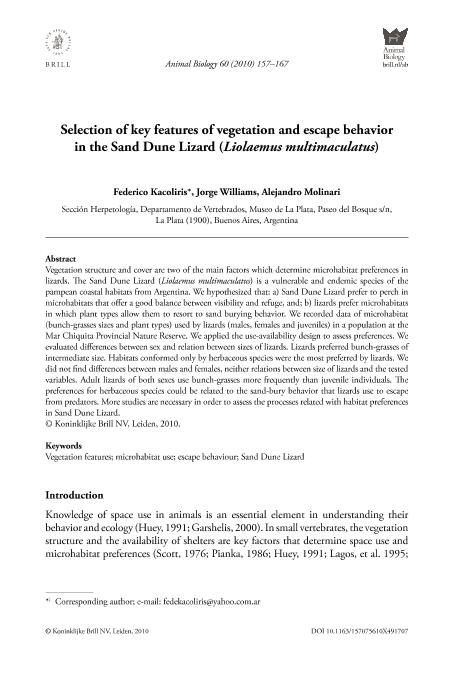Mostrar el registro sencillo del ítem
dc.contributor.author
Kacoliris, Federico Pablo

dc.contributor.author
Williams, Jorge Daniel

dc.contributor.author
Molinari, Alejandro
dc.date.available
2023-04-10T13:49:20Z
dc.date.issued
2010-02
dc.identifier.citation
Kacoliris, Federico Pablo; Williams, Jorge Daniel; Molinari, Alejandro; Selection of key features of vegetation and escape behavior in the sand dune lizard (liolaemus multimaculatus); Brill Academic Publishers; Animal Biology; 60; 2; 2-2010; 157-167
dc.identifier.issn
1570-7555
dc.identifier.uri
http://hdl.handle.net/11336/193026
dc.description.abstract
Vegetation structure and cover are two of the main factors which determine microhabitat preferences inlizards. Th e Sand Dune Lizard ( Liolaemus multimaculatus ) is a vulnerable and endemic species of thepampean coastal habitats from Argentina. We hypothesized that: a) Sand Dune Lizard prefer to perch inmicrohabitats that off er a good balance between visibility and refuge, and; b) lizards prefer microhabitatsin which plant types allow them to resort to sand burying behavior. We recorded data of microhabitat(bunch-grasses sizes and plant types) used by lizards (males, females and juveniles) in a population at theMar Chiquita Provincial Nature Reserve. We applied the use-availability design to assess preferences. Weevaluated diff erences between sex and relation between sizes of lizards. Lizards preferred bunch-grasses ofintermediate size. Habitats conformed only by herbaceous species were the most preferred by lizards. Wedid not fi nd diff erences between males and females, neither relations between size of lizards and the testedvariables. Adult lizards of both sexes use bunch-grasses more frequently than juvenile individuals. Th epreferences for herbaceous species could be related to the sand-bury behavior that lizards use to escapefrom predators. More studies are necessary in order to assess the processes related with habitat preferencesin Sand Dune Lizard.
dc.format
application/pdf
dc.language.iso
eng
dc.publisher
Brill Academic Publishers

dc.rights
info:eu-repo/semantics/openAccess
dc.rights.uri
https://creativecommons.org/licenses/by-nc-sa/2.5/ar/
dc.subject
ESCAPE BEHAVIOUR
dc.subject
MICROHABITAT USE
dc.subject
SAND DUNE LIZARD
dc.subject
VEGETATION FEATURES
dc.subject.classification
Ecología

dc.subject.classification
Ciencias Biológicas

dc.subject.classification
CIENCIAS NATURALES Y EXACTAS

dc.title
Selection of key features of vegetation and escape behavior in the sand dune lizard (liolaemus multimaculatus)
dc.type
info:eu-repo/semantics/article
dc.type
info:ar-repo/semantics/artículo
dc.type
info:eu-repo/semantics/publishedVersion
dc.date.updated
2023-04-10T10:21:46Z
dc.journal.volume
60
dc.journal.number
2
dc.journal.pagination
157-167
dc.journal.pais
Países Bajos

dc.journal.ciudad
Leiden
dc.description.fil
Fil: Kacoliris, Federico Pablo. Universidad Nacional de La Plata. Facultad de Ciencias Naturales y Museo. División Zoología de Vertebrados. Sección Herpetología; Argentina. Consejo Nacional de Investigaciones Científicas y Técnicas. Centro Científico Tecnológico Conicet - La Plata; Argentina
dc.description.fil
Fil: Williams, Jorge Daniel. Universidad Nacional de La Plata. Facultad de Ciencias Naturales y Museo. División Zoología de Vertebrados. Sección Herpetología; Argentina. Consejo Nacional de Investigaciones Científicas y Técnicas. Centro Científico Tecnológico Conicet - La Plata; Argentina
dc.description.fil
Fil: Molinari, Alejandro. Universidad Nacional de La Plata. Facultad de Ciencias Naturales y Museo. División Zoología de Vertebrados. Sección Herpetología; Argentina
dc.journal.title
Animal Biology

dc.relation.alternativeid
info:eu-repo/semantics/altIdentifier/url/https://brill.com/view/journals/ab/60/2/article-p157_5.xml
dc.relation.alternativeid
info:eu-repo/semantics/altIdentifier/doi/http://dx.doi.org/ 10.1163/157075610X491707
Archivos asociados
